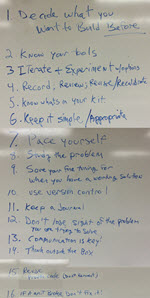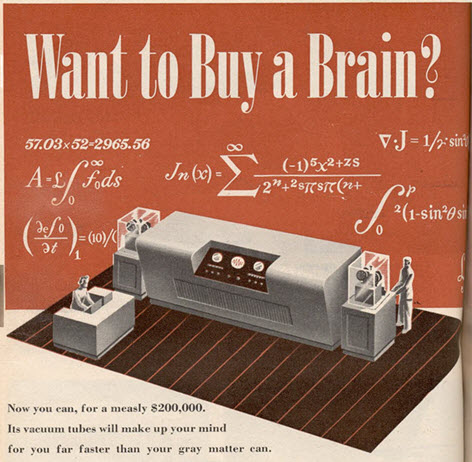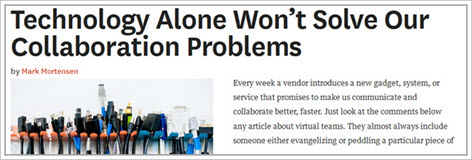Will IBM Verse make you more productive than before?
Tuesday, May 12th, 2015If you use eProductivity or have some interest in it, head over to Inside.eProductivity for the details: click here.
A new way to work that’s over 10 years old
Monday, May 11th, 2015A few years later, I came out with eProductivity, which has been introducing IBM software users to David's "GTD" methods ever since. For typical professionals who are stressed out, overloaded, and dominated by the latest and loudest thing in their inbox, eProductivity is a fantastic new way to work.
You might say, "10 years old? That's ancient for software!" Remember, Microsoft Word came out in 1989.
What's more, eProductivity is a proven way to work, which is more than can be said for all the advertising fluff floating around.
I know that sounds like I'm bragging, but I don't have to say a thing about eProductivity. People who use it say these things for me. For example, one of my managers just posted this fantastic customer story from an IBMer on Inside.eProductivity.
Here are a few choice quotes:
I have now been using eProductivity for almost three years. When I first installed eProductivity, I had approximately 700 emails in my in-box . . . I now rarely have more than 6-10 emails in my in-box, and I am almost always able to end the day with none.
I am also able to view, in a simple and intuitive way, all of the actions I need to take and the individuals that I waiting to provide me with information.
With eProductivity, I feel that I am always on top of my emails, actions, requests for information, and calendar. As mentioned above, my in-box is almost always at zero, while at the same time I know I have every required action covered that was initiated by an email. It allows me to feel like I am in control of my time.
"I am in control of my time." Mission accomplished. I created eProductivity in the course of my consulting work to help frustrated users of IBM software achieve this exact thing.
Do you feel in control of your time, using whatever tools you have, working however you work?
GTD: the secret sauce of eProductivity
"Getting Things Done," is a personal productivity method used by millions of people around the world (including me) to gain clarity and focus in their work. It's based on the principles from the international bestseller, Getting Things Done: The Art of Stress-Free Productivity, by my colleague David Allen.
This set of habits and practices, known as GTD for short, helps people:
- Process all their inputs in a way that make sense. This includes, email, voicemail, snail mail, idea, notes, conversations, articles -- any source of information that means something to you.
- Get a clear view of what they need to do
- Decide what's most important to do
- Do it
- Review what they've done and need to do, to make sure nothing slips through the cracks
For more about GTD, see here.
The power of GTD is built into eProductivity from the ground up: eProductivity is designed to support, facilitate, enable, and (to a certain extent) teach the habits and practices of GTD.
I've personally been using GTD for over 20 years, and it's been enormously effective in my life and work. I originally designed eProductivity to help bring this power to my consulting clients.
Getting Things Done with eProductivity is a real, proven, new way to work
The methods of GTD are simple, intuitive, incredibly powerful, and radically different from how most people work, and it's been catching on since 2001. All it takes is learning to think about your work in a new way.
Let me make that clear: a real new way to work starts with how you think about your work, not with a fancy new piece of software. So even though GTD may not have been born yesterday (or even this year), it's still very new to the hundreds of people discovering it every day.
In the same way, eProductivity has the power to take frustrated, overloaded IBM software users and introduce them to a whole new way to get clarity and focus. Prompts are built into the program to get professionals to think differently about their work, which includes their to-do lists, supporting information, and waves of "stuff" coming at them every day.
I have no plans to stop using eProductivity. All the shiny new programs I've tried that promise a new way to work have turned out to be simple email clients with a few bells and whistles thrown in, plus the promise to serve up only what's important to you so you can ignore everything else. So far, that hasn't panned out. Even if it did, these programs still don't give me the tools I need and want to get clarity and focus in the midst of information overwhelm.
The new players are still unknown (and based on what I've seen so far, my hopes are not high). What is known is that many, many people have been successfully getting things done with eProductivity for over a decade.
I'll keep introducing people to a new way to work for as long as I can, which I hope will be for some time.
More about GTD:
The Atlantic: Busy and Busier: Productivity expert David Allen talks with James Fallows about the future of getting things done
That National: Freeing Your Mind to Get Things Done
Best Practices for Robotics Competitions, Work, and Life in General
Wednesday, May 6th, 2015 I really enjoy consulting and coaching executives and other professionals, because it allows me to make a difference in the lives of others. There's nothing like that moment when their eyes widen and they say "I get it!" or "That's cool!"
I really enjoy consulting and coaching executives and other professionals, because it allows me to make a difference in the lives of others. There's nothing like that moment when their eyes widen and they say "I get it!" or "That's cool!" I also get to experience this same thing with students in my Intro to Robotics course. This course isn't just a bunch of computer science geeks doing geeky things: I use it to prepare my students to work well, both in their personal and professional lives, by teaching them essential life skills.
I know teaching life skills through robotics sounds far-fetched, so I'm going to prove it below.
 In this course, one of the exercises I teach is the After-Action Review. This consists of five questions:
In this course, one of the exercises I teach is the After-Action Review. This consists of five questions: 1. What was supposed to happen?
2. What actually happened?
3. Why did it happen?
4. What did we learn?
5. How can we do better next time?
On Monday, as I lead them through an After-Action Review, I wrote the answers to the final question on the board (as you can see on the left). The action under review was the students' preparation for their final in-class competition (which involved designing and building a robot in teams), but the answers they came up with also translate to work and life in general.
Note that these are not in order of importance or priority. They're all lessons learned. Here's what my students had to sayplus applies to best practices for life:
Continue Reading "Best Practices for Robotics Competitions, Work, and Life in General" »
Technology alone won’t fix how we work (and work together)
Monday, May 4th, 2015My first paid consulting job convinced me that technology would solve all our problems. Over 30 years ago, I was writing flight-planning programs with a 1-kilobyte* programmable calculator, and it was incredible: calculations that took hours by hand were done in a few minutes.
What I didn't see then was the whole picture. Technology is (and always has been) only part of the equation. My client and I had to put our knowledge together: his knowledge of the math needed for flight-planning, and my knowledge of how to write that into a program.
What I've discovered is that machines can never do our thinking for us – even though advertisers have been claiming they can for decades. Exhibit A:

"Its vacuum tubes will make up your mind for you far faster than your gray matter can." Somehow I'm reminded of modern ads claiming that technology can decide what's important to you.
What I found out
During my graduate research on how people work. I saw that even people with the best technology could work very ineffectively. At the same time, some people could use outdated equipment – even as simple as pen and paper – and create great value for their organization. Obviously, technology alone didn't make people better workers.
It became clear that technology is useless if people don't know how to work with it – and more importantly, use it to work together.
Based on my experience and research, I came up with this equation as a model for the effectiveness of individuals and teams:
Value (V) = Knowledge (K) x Methodology (M) x Technology (T)
Technology is literally only part of the equation. There are two other factors:
- Methodology: the habits, rules, and practices that people follow to get work done. In other words, how people work.
- Knowledge: what you know, who you know, and what they know
Let me go back to the flight-planning example:
- K = my client's knowledge of the mathematics needed for flight-planning
- M = my process for translating that math into programs
- T = the 1-kilobyte programmable calculator
Without all three, our operation wouldn't have worked and I would've been out of a job.
A kindred spirit
I was delighted to come across a very insightful article that Mark Mortensen of INSEAD recently wrote for the Harvard Business Review: "Technology Alone Won't Solve Our Collaboration Problems." He emphasizes "a simple truth: it’s not what technology you’ve got, but how you use it" and includes three specific examples of how to work more effectively with today's technology.
I'm glad to find someone who recognizes "it’s less important which technology you choose and more important that you align it with how people do work." Mortensen acknowledges the importance of method and knowledge as well as technology. See here for his article.

Three factors to success
The interaction of knowledge, methodology, and technology is critical to any organization's success and the value of any individual's work. This is what I've brought to my consulting clients over my decades in the field, and I've clearly seen the results: it works.
To share your thoughts on this topic, connect with me on social media (below). When you're ready discuss how I can help you and your organization manage the balance of KMT, click "Contact" in the upper-right. I'd love to chat!
Best,
Eric
*For the younger crowd: 1 kilobyte is about 1/16,000,000 of the memory of a standard iPhone 6.
Image credit:
"Buy a Brain" image by DigiBarn [CC BY-NC 3.0 (http://creativecommons.org/licenses/by-nc/3.0/)]. Changes made: image rotated clockwise 1 degree; article text cropped out; additional border coloring added. Scanned by DigiBarn from Popular Science, May 1949. Link to original image: http://www.digibarn.com/collections/mags/popsci-may-1949/brain1.jpg
Email in real life
Monday, April 13th, 2015Here are a couple I'd like to point out:
- If you really need a report (or anything else) ASAP, email is probably not the best way to ask (especially if your reader is getting hundreds of emails a day)
- Only use "Reply All" if every single person in the conversation needs to know what you're saying
Yes, Tripp & Tyler are right that people use email for the wrong things. But that doesn't make it a bad tool. Like we've said before, email is not the problem: how people use it is the problem.
Would this be a bad time to mention that you can get our Top 10 Email Tips by following Inside eProductivity? These are completely, 100% guaranteed to make everyone want to respond to every one of your emails, all the time.*
Best,
Nathan
@eProductivity
FB: eProductivity
*Unless they don't feel like it, or yours is the 180th email they've received today, or they're in a meeting, in which case the full faith of this absolute guarantee is annulled, abrogated, eliminated, invalidated, abolished, expunged, undone, and annihilated. The tips are still good, though, and with them you're still more likely to get a response than without. And they're free!






